-
Posts
14,343 -
Joined
-
Last visited
-
Days Won
25
Content Type
Profiles
Forums
Blogs
Gallery
Events
Store
Posts posted by Ed_Haynes
-
-
-
Even when you try not to remember what the medal represents . . .

 0
0 -
(Though the obverse here is nicer . . . though also geographically fantastical.)
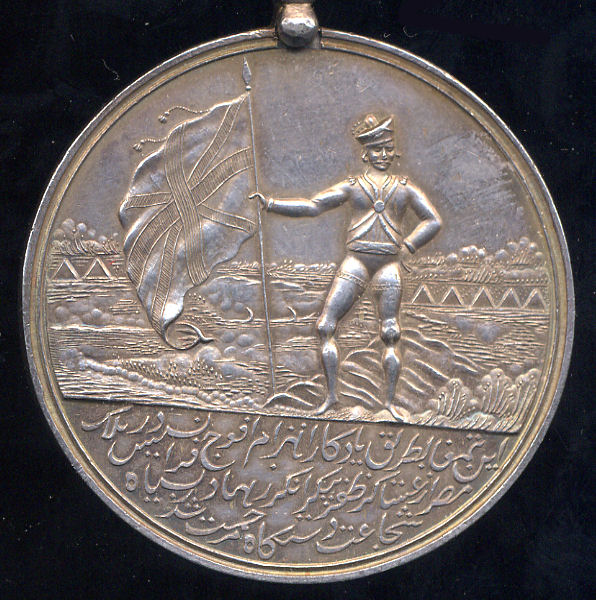
 0
0 -
And even the stuff that is geographically laughable . . .
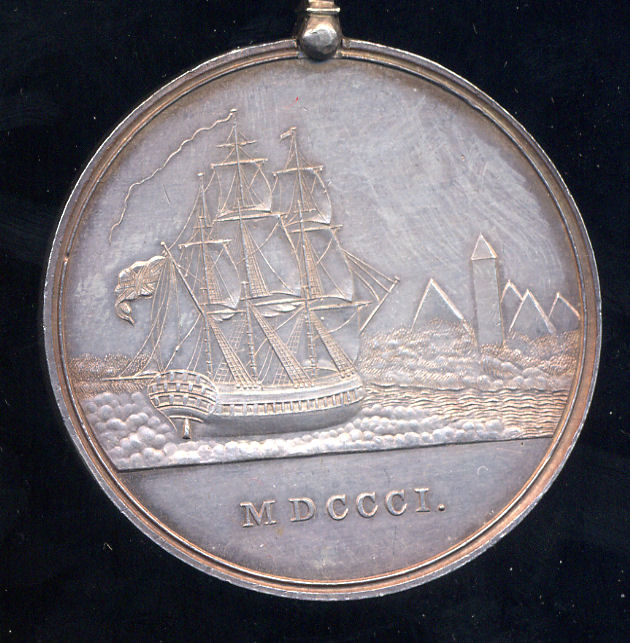
 0
0 -
-
So true, Chris, so true. (Although this is actually the obverse, we've been taught to see it as the reverse.)

 0
0 -
Michel,
"Compensate" is fully acceptable. You also could have used "balance"... What do you think, you english native speakers ?

Ch.
Jo aap ki merzi ho, Chrisopheji, un men se to koi farq nahin ho!
Sorry, that was Hindi!
Malesh. (Egyptian Arabic is is so much easier = Not to worry.)
Same-same, mate, no worries. (If OK in Ozzie?)
Itz okay wifff me. (In Akerkin.)
 0
0 -
Hello,
Thanks,
My English is so bad that I don't dare to send a message ; fortunatly I have some pictures to compensate (I don't think that ''compensate'' is very British )

Regards
Michel
No worries about language, Michel. we are global and have so much fun sharing that language doesn't matter! Welcome. We need wisdom!!
Aucune inqui?tude de la langue, Michel nous sommes globaux et nous amusons tellement en partageant cette langue n'a pas d'importance! Accueillir. Nous avons besoin du bon sens!!
(How bad is that? Comment est mal cela?)
0 -
-
Yuri has some limited (and Russian) information and lovely images of some of these:
Order of the Republic - http://www.netdialogue.com/yy/Europe/Spain/ORep/ORep.htm
Order of Liberation - http://www.netdialogue.com/yy/Europe/Spain.../Liberation.htm
Campaign Medal 1931 - http://www.netdialogue.com/yy/Europe/Spain/Camp1931/Camp.htm
With all the habitual focus on the fascists, we really need to know more about the government awards.
0 -
Yuri has some images (but little information) on the pre-Liberation variety on his site:
http://www.netdialogue.com/yy/America/Cuba...es/Cespedes.htm
1 -
Welcome Antonio. Good to see you and your immense knowledge here!
Ed
0 -
October 6 Memorial Medal
Awarded to all armed forces personnel in service between 6 October 1973 and 2 February 1974. The medal can also be awarded to foreigners who actively contributed to the war effort, including combat service.
Established: 19 February 1974?
Ribbon: 38 mm, moire an 11 mm yellow central stripe with a central 3 mm thin blue stripe; edge stripes (reading inward) of black (1 mm) and red (11 mm). When worn as a ribbon bar, a brass disk with the number ?6? (?6?) is (sometimes? why?) worn on the ribbon.


 1
1 -
Bronze Star for Egypt, 1882
Awarded to Egyptian and allied (=- Briotish and "imperial") troops for the campaigns between 16 July and 14 September 1882.
Established: By Khedive Tawfiq Muhammad, with the nominal authorization of the Ottoman Sultan. Manufactured by Jenkins (Birmingham, England).
Obverse: A five-pointed bronze star, point downward and suspended by a crescent and star from a straight suspension bar. In the center, a depiction of the Sphinx and three pyramids. Around it, the inscription "EGYPT 1882".
Reverse: The Khedive's monogram, "T.M." with a crown above.
Ribbon: 39 mm, dark blue.
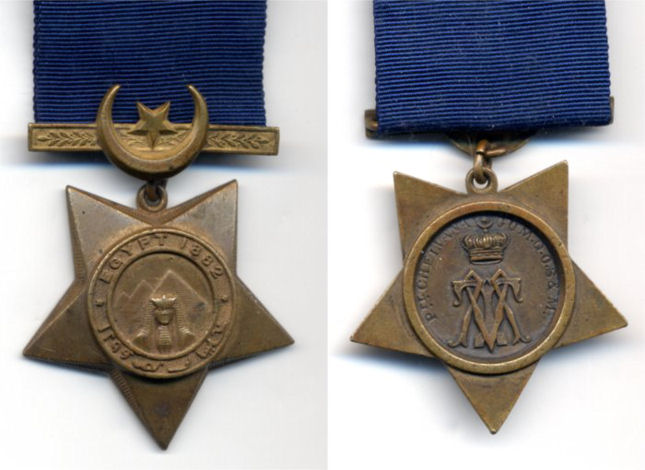

 1
1 -
Nishan al-Sinaa wa al-Tigara / Order of Industry and Commerce
A rpoyal award continued under the Republic.
Established: By King Ahmad Fuad I in Royal Order No. 63 of 1932. Redesigned after the Revolution. Known to have been manufactured by Bichay (Cairo, Egypt).
Obverse: A five-pointed, orange-enameled silver-gilt star; the points are curved with medium ornaments on each and forming a second five pointed star within the orange outer star. Behind this, faceted silver rays between each point. In the red- and white-enameled center a gold Arabic inscription. Suspended from a silver cog wheel, gold caduceus, and gold laurel branch.
Ribbon: Blue, yellow edge stripes and narrow green edges.
Commander - neck badge
Officer - breast badge with ribbon rosette
Knight - breast badge
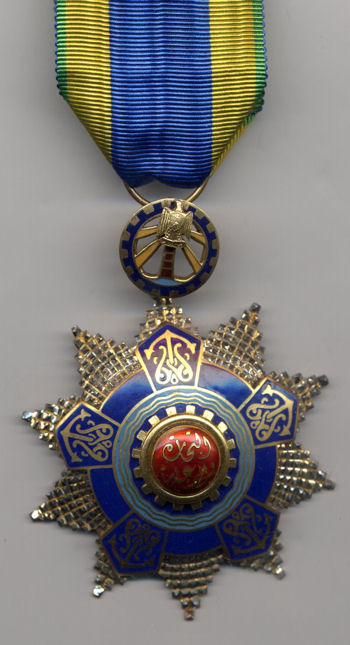

 1
1 -
Nishan al-Kemal / Order of the Virtues
Established as an award of merit for women only.
Established: By Sultan Husayn Kamil in 1915 (or 1913?), Modified in Royal Order No. 7 of 1923. Reestablished by Law No. 528 of 1953 and amended by Law No. 12 of 1972.
Obverse: A star of ten gold ornamental lotus flowers, alternately enameled blue and white. In the center, white with "El-Kemal" or "The Virtues" in blue. In the points of the breast star of the two upper classes are the words "Charity", "Duty", "Devotion", "Nobility", and "Pity". Before 1954, it was suspended by a gold and enamel crown; after that date, the crown was removed.
Ribbon: Light gray moir? with gold tissue edging. Also reported as red moir? edged with gold.
first design with crown (1915-54):
--- Superior Class - 100-mm sash (worn over right shoulder), 45-mm sash badge, and 70-mm gold, enamel, and precious stone-set breast star (worn on left breast) - set with jewels with dark and light blue-enameled flower designs - center is a blue inscription on white - granted to the wives of heads of state, crown princes, or vice presidents
--- Grand Cordon/first class - 80-mm sash (worn over right shoulder), 45-mm sash badge, and 70-mm gold and enamel breast star (worn on left breast) - dark and light blue-enameled flower designs - center is a blue inscription on white - granted to the wives or premiers and ministers
--- second class - 55-mm badge worn on a 31-mm breast bow with ribbon rosette - gold and light blue-enameled flower designs - center is a dark blue inscription on light blue - granted to the wives of ambassadors
--- third class - 45-mm badge worn on a 31-mm breast bow - medium blue and light blue-enameled flower designs - center is medium blue on light blue - awarded to wives of diplomatic counselors and attaches
second design without crown (1954--):
--- Supreme Class - 100-mm sash (worn over right shoulder), 45-mm sash badge, and 70-mm gold, enamel, and precious stone-set breast star (worn on left breast) - set with jewels with dark and light blue-enameled flower designs -granted to the wives of heads of state, crown princes, or vice presidents
--- first class - 80-mm sash (worn over right shoulder), 45-mm sash badge, and 70-mm gold and enamel breast star (worn on left breast) - dark and light blue-enameled flower designs - granted to the wives or premiers and ministers
--- second class - 55-mm badge worn on a 31-mm breast bow with ribbon rosette - gold and light blue-enameled flower designs - granted to the wives of ambassadors
--- third class - 45-mm badge worn on a 31-mm breast bow - medium blue and light blue-enameled flower designs - awarded to wives of diplomatic counselors and attaches (SHOWN BELOW)


 1
1 -
Order of Merit
Awarded for valuable services to Egypt.
Established: Established by Law No. 528 of 1953, amended by Law No. 12 of 1972. Known to have been manufactured by Bichay (Cairo, Egypt).
Obverse: A ten-pointed star, with alternating points of alternately rayed gold and faceted silver. In the center, a five-point star with curved sides and a blue-enameled center with a gilt Arabic legend "Merit". Suspended by an eagle (until 1972) or hawk (after 1972).
Ribbon: Red moir? with edge stripes (reading inward) of thin black and white.
Grand Cordon/first class - sash (worn over ??? shoulder), 60-mm sash badge, and 80-mm star (worn on left breast)
second class - 55-mm neck badge (38-mm ribbon) and 70-mm breast star (worn on left breast)
third class - 55-mm neck badge (38-mm ribbon)
fourth class - 45-mm breast badge worn on 38-mm ribbon with rosette
fifth class - 45-mm breast badge worn on 38-mm ribbon (SHOWN BELOW)


 1
1 -
Wisam Negma Sinna' / Order of the Sinai Star
The highest award for bravery in battle, it is awarded to any member of the armed forces for exceptional courage in battle which results in the infliction of casualties upon the enemy. All awards were bestowed by the president, Anwar al-Sadat. The star may also be awarded posthumously and to foreigners. The first class carries a monthly pension of ?E20, while the second class carried a similar payment of ?E10. Sons or heirs of holders of this award receive free education, free land travel, air and sea travel at 50% cost, free medical treatment, and general priority in the provision of state-rendered services. While the badge was, officially, worn as a breast badge, the late Egyptian President Anwar al-Sadat (with whom the award is closely identified) wore the badge as a neck badge. The actual badge he wore was the second class Sinai Star which had been posthumnously awarded to his half brother. This decoration is often, and incorrectly, referred to as the "Suez Star". This error in nomenclature reflects the award's close symbolic identification with the 1973 war and the heroic Egyptian crossing of the Suez Canal as the first step in the reconquest of the Sinai Peninsula.
Established: By Law No. 12 of 1972, revised 17 February 1974, by President Anwar al-Sadat.
Obverse: An eight-pointed star, dark green-enameled (it looks almost black), with slightly different designs for each class, as detailed below.
Reverse: Plain, but with provision for engraving the award details.
Ribbon: 37 mm, three equal stripes: red, white, black. When worn as a ribbon bar, the stripes are horizontal: red, white, and black, where a gold republican eagle is worn to represent a first class award.
Awards: It is, at present, difficult to distinguish by classes, but at least 54 (25 posthumous) were awarded for the 1973 war with Israel (although total awards for this conflict may have been as high as 200). The only documented awards since that conflict came in 1978 for an airline rescue attempt in Cyprus when 15 posthumous awards were made (2 to the Air Force and 13 to Army commandos). In 1983, President Mohammed Hosni Mubarak was awarded the first class.
first class - a 45-mm gold dark green-enameled badge, in the circular enameled center, a map of the Sinai Peninsula, the legend "Nigan al-Sinna'" or"Sinai Star", and with square-pointed gold rays between the points. Suspended from a wide straight-bar ornate suspender by an ornamental Egyptian eagle (hawk?).
second class - a 46-mm gold dark green-enameled star, in the center "Sinai / 1973" in gold. Suspended by a simple, almost wire-like, straight-bar suspender.
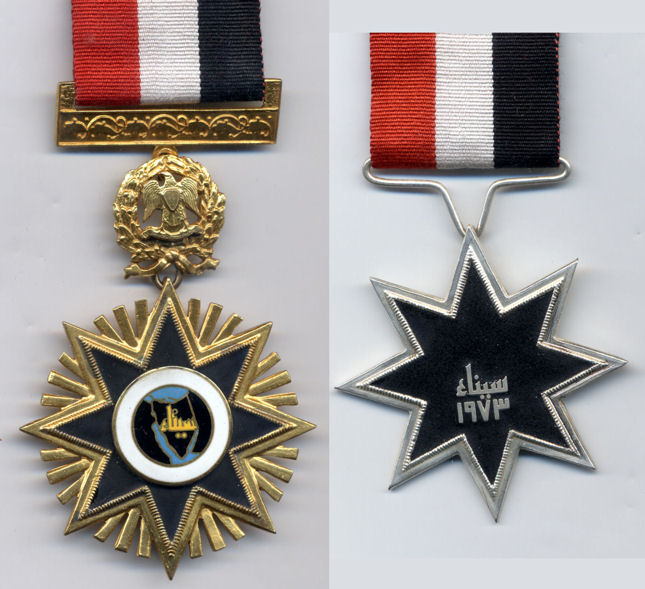

 1
1 -
Midalat Al-Khidmat al-Tawilat wa al-Qarafat al-Hasanat / Medal of Long Service and Good Example
Granted to those members of the armed forces who serve a minimum of twenty years. The first class is awarded to commissioned officers and the second class to others.
Established: 1959, revised by Law No.6 of 1972.
Obverse: Circular medal, 37 mm. Within a circle and border of twenty stars, the eagle or hawk emblem of the republic. Suspended by an ornate suspender from a straight-bar suspender (also reported in a ring-suspension variety?).
Reverse: At the top, the Arabic inscription indicating the issuing body, as detaile dbelow. In the center, "Al-Khidmat al-Tawilat / wa al-Qarafat al-Hasanat" or "Long Service and Good Example", and below "1959-1378" or "1959-1378", the date(s) of establishment of the medal (A.H. and C.E.). The medal is often hallmarked to the left.
Ribbon: 37 mm, white, with narrow edge stripe of (reading inward) of red, white, and black: 2.5 mm red, 2.5 mm white, 2.5 mm black, 22 mm white, 2.5 mm black, 2.5 mm white, 2.5 mm red.
1959-71 U.A.R. eagle and reverse inscription "Al-Jamhuriya al-'Arabiya al-Matahada" or "United Arab Republic":
--- first class - silver - awarded to commissioned officers
--- second class - bronze - awarded to non-commissioned officers and privates
post-1971 hawk and reverse inscription "Jamhuriya Misr al-Arabiya" or "The Arab Republic of Egypt":
--- first class - silver - awarded to commissioned officers (SHOWN BELOW)
--- second class - bronze - awarded to non-commissioned officers and privates


 1
1 -
Nuut al-Waagib al-'Askarii / Medal of Military Duty
This represents a direct continuation of the royalist Medal for Devotion to Duty in its military aspects. The civilian aspect of the pre-Revolutionary award is continued as the Medal of Civil Duty. Awarded for faithful and courageous performance of non-combattant duty to members of the armed forces, regardless of rank. This includes potential awards to cadets at service academies. Can be awarded posthumously and to foreigners.
Established: Reformulated on 9 July 1953 and revised by ??? of 1959 and by Law No. 6 of 1973.
Obverse: Circular 31 mm medal, an upright sword above a pair of wings with a wreath beneath these, the whole surrounded by ten stars. Suspended by an ornate suspender from a straight bar.
Reverse: At the top, an Arabic legend indicating the name of the issuing nation; this changes over time, as is detailed below. In the center "Nuut al-Waagib al-'Askarii" or "The Medal Military of Duty", and below "1953-1372" or "1953-1372", the date(s) of establishment of the medal (A.H. and C.E.).
Ribbon: After 1953, the old ribbon was continued for the civil class, while a new ribbon was established for the military class by adding a narrow red stripe toward each edge. For the military awards it is 36 mm, medium blue with a thin red stripe toward each edge: 5 mm blue, 3 mm red, 20 mm blue, 3 mm red, 5 mm blue.
reverse inscription "???, 1953-59:
--- silver-gilt
--- silver
--- bronze
reverse inscription "Al-Jamhuriya al-'Arabiya al-Matahada" or "United Arab Republic", 1959-71 (actually altered in 1973?):
--- silver-gilt
--- silver (SHOWN BELOW)
--- bronze
reverse inscription "Jamhuriya Misr al-Arabiya" or "The Arab Republic of Egypt", after 1971 (actually altered in 1973?):
--- silver-gilt
--- silver
--- bronze
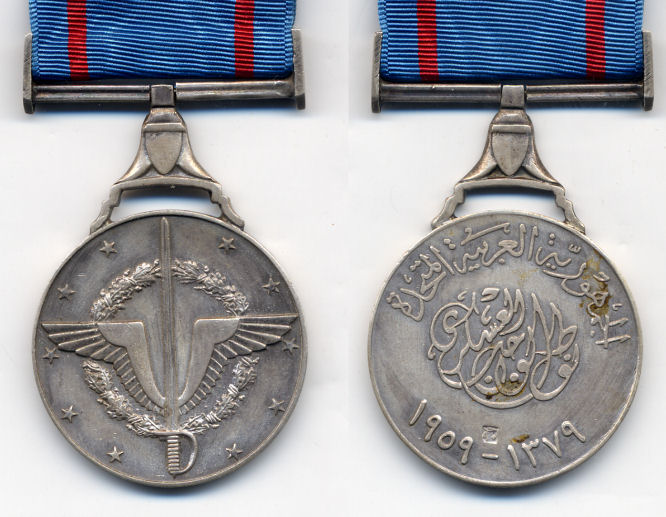

 1
1 -
Nishan al-Ziraah / Order of Agriculture
This order seems to have been quite rarely awarded, in part because the goals of the order were viewed less than sympathetically by Great Britain, Egypt's imperial "protector". Awards continued under the Republic.
Established: By King Ahmad Fuad I in Royal Order No. 61 of 1932 (or 1923?). Redesigned after the revolution.
Obverse: A five-armed cross, enameled white with red diamonds on each arm and a silver crescent and three stars at the end of each arm. In the central red-, green-, and white-enameled medallion, Arabic inscription. Suspended (for the two higher classes) from an emameled crown. After the revolution, this was substituted by an green-enameled lotus flower.
Ribbon: Light green, with three separate edge stripes thin pink, yellow, and thin pink. The colors are sometimes described as darker?
Commander - neck badge (SHOWN BELOW)
Officer - breast badge with ribbon rosette
Knight - breast badge without crown suspension
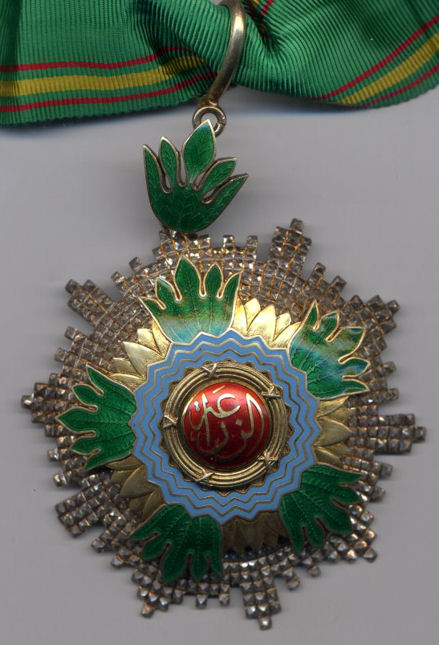

 1
1 -
Nut al-Tadrib / Medal of Training
Granted to those who, with their units, achieve a high standard of training or to those injured as a result of training.
Established: 1959, revised by Law No. 6 of 1973. Obverse: 32 mm circular medal with a (rather "busy") depiction of a leaping soldier in full battle gear and, below, barbed wire, a sword, an open book, and a quill pen. To the right is a crescent, points downward, and sixteen smaller stars, a warship, and two explosions. Above the soldier are two open parachutes and, to the left, a sun, tank, and two more explosions.
Reverse: The Egyptian eagle or hawk and, on either side, "1959-1379" or "1959-1379", the date(s) of establishment of the medal; below, the inscription "Nut al-Tadrib" or "The Medal of Training". Suspended by an ornate suspender from a straight bar. The medal is hallmarked to the botton of the reverse.
Ribbon: 39 mm, white with two equally proportioned red stripes: 7.5 mm white, 8 mm red, 8 mm white, 8 mm red, 7.5 mm white.
U.A.R. eagle, 1959-71 (1973?):
--- first class - gold - suspended from a swiveling suspender (SHOWN BELOW)
--- second class - silver
--- third class - bronze
hawk, post-1971 (1973?):
--- first class - gold - suspended from a swiveling suspender
--- second class - silver
--- third class - bronze


 1
1 -
W NIB 11 -- The 1st Workers' Spartakiada
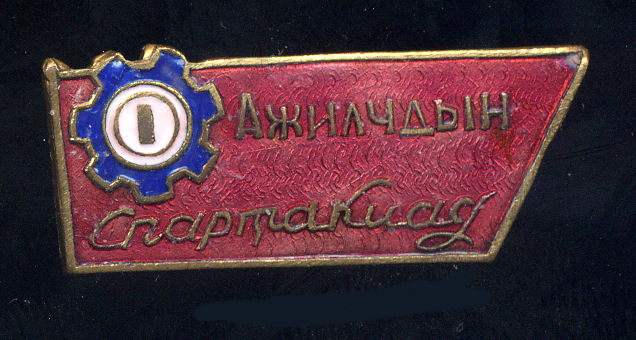

 0
0 -
S NIB 09 -- 30 Years of the Mongolian Book Trade
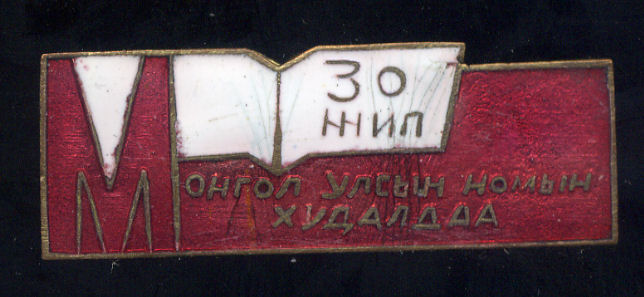
 0
0




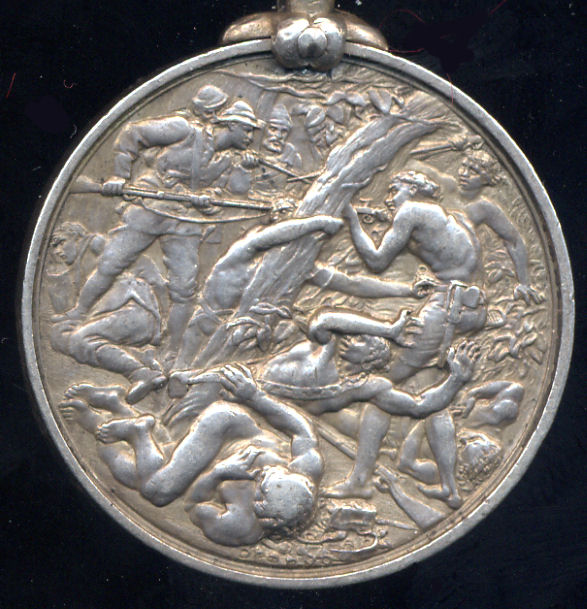

The art on the flip side......
in Great Britain: Orders, Gallantry, Campaign Medals
Posted · Edited by Ed_Haynes
Yes. Though the specimen I posted is almost in TOO NICE condition to scan properly. Too reflective.
(Actually have my "babies" home for "sorting" -- playing with -- this weekend .)
.)